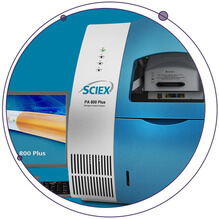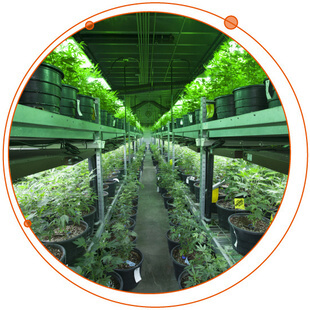Each year, the Drug Enforcement Administration (DEA) Special Testing and Research Laboratory publishes an Emerging Threat Report. The data contained in the report is updated quarterly and represents a snapshot of the drug evidence seized and analyzed by the DEA in the...
Tags
Pharma perspectives: The influence of LC-MS innovation on drug development outsourcing
It is no secret that (bio)pharmaceutical research and development is complex, both scientific and regulatory processes. Working for a contract research organization and more recently for SCIEX has provided an interesting perspective on trends the market experiences that affect many of us.
Overcoming uncertainty in your PFAS analysis
Just like gum on the bottom of a shoe, the existence of per- and poly-fluorinated alkyl substances (PFAS) in our environment is a sticky one. If you’re in the field of environmental testing, then you’re all too familiar with the threat these substances have on public health. While we have learned a lot about them over the years, there is still much more to understand. With the right detection methods, we can gather the information we need to empower us to make informed decisions on reducing the risks they impose.
6 Signs it’s time for a new vendor
A lab’s success depends on many factors from instrument quality to efficient operations, including being partnered with the right vendor. A vendor is more than just a supplier. They should provide you with a high-level quality of support in maximizing the lifespan and performance of your systems, reducing downtime, enhancing ROI and more. How do you know if you’re partnered with the right one? Here are six signs it might be time to find someone new.

Selecting an LC-MS system for quantitation of pharmaceutical drug development
We understand you are busy, needing to prioritize running instruments, reporting results and managing your laboratory to meet deadlines. We created a solution guide to explain how SCIEX systems fit in the drug development pipeline to save you time evaluating options.

Nitrosamines: Where are we now?
Nitrosamines are a large group of N-nitroso compounds that share a common functional N-N=O group. They are produced by a chemical reaction between a nitrosating agent and a secondary or tertiary amine. Back in 2018, nitrosamines suddenly found themselves in the spotlight when they were unexpectedly detected in medications for high blood pressure. Since then, they have been found in several other prescription medications, including those for heartburn, acid reflux and diabetes, resulting in manufacturers recalling some common medications.

Celebrating customer experience: Insights from SCIEX leaders
Introduction Customer Experience Day (CX Day) is a special occasion for SCIEX, celebrated every first Tuesday in October. It’s a day dedicated to recognizing the incredible value of our customers and the relentless dedication of our associates who strive to make...

PFAS analysis in food: a robustness study in sensitivity and stability
The combination of per- and polyfluoroalkyl substances (PFAS) testing, trace-level regulatory requirements and complex MS applications can be intimidating. In a recent webinar, now available on demand, SCIEX PFAS expert Craig Butt demonstrated how the new SCIEX 7500+ system can help make PFAS testing easier.

Your success and voice go a long way!
At the heart of everything we do is ensuring that your workflows and team are empowered to achieve optimal results with your SCIEX instruments, software, consumables, and services. Every interaction with SCIEX is designed to support your success through the dedication...

FDA’s final rule on LDTs: what does it mean for clinical laboratories?
On April 29, 2024, the U.S. Food and Drug Administration (FDA) announced a final rule regulating laboratory developed tests (LDTs) as in vitro diagnostic devices (IVDs) under the Federal Food, Drug and Cosmetic Act (FD&C Act). This rule amends FDA’s regulations to state that in vitro diagnostic tests “manufactured” by clinical laboratories fall within the scope of the FDA regulatory oversight and is poised to dramatically shift the way clinical diagnostic laboratories in the United States develop and offer LDTs in the future. Read this blog post for a basic overview of the scope, intent and implications of this final rule, including the regulatory requirements, exceptions and timeline for implementation.

LC-MS system replacement: Are you ready?
Meeting deadlines in a bioanalysis laboratory can be a big challenge. Older, less sensitive and less reliable LC-MS systems make it even more difficult. Even the disruption caused by the installation and validation can be disconcerting and delay decisions. Does this sound familiar?

Food Testing Labs: What Technology Is Right for You?
Consumer safety is the driving force behind food analysis. From field (or ocean) to fork, there are numerous opportunities for food to become potentially hazardous to human health. As fast as new contaminants enter the food chain, changes in regulation and legislation...

Fueling Up: Eating To Stay Strong When You Have Cancer
This is the third and final post in our series in honor of International Women’s Day and our collaboration with World Cancer Research Fund. To wrap up, Deborah Howland talks about the importance of diet for anyone facing cancer – or trying to prevent it. A specialist...

5 Demands of Forensic Toxicologists and the Ultra-Fast Method That Meets Them
There just isn’t a screening approach available that can give us everything we need when throughput is the priority. Sound familiar? For many toxicology labs, there is a misconception that compromises need to be made when it comes to high throughput drug screening....

Uncovering the Links Between Childhood Growth, Body Size, and a Woman’s Risk of Breast Cancer
Welcome to the second in a series of posts marking International Women’s Day, and our ongoing support of World Cancer Research Fund. This installment is a review by Dr. Jennifer Baker, of her work, that, with the help of a WCRF grant, is studying body size and its links to breast cancer. Dr. Baker, Lead Investigator at Denmark’s Frederiksberg Hospital, has a Ph.D. in Human Nutrition from Cornell University. Her research focuses on clinical epidemiology.

Global Trends That Will Affect Neonicotinoid Usage in 2019
Neonicotinoids have become the most widely used class of insecticide in the world, with registration in 120 countries. However, these pesticides have become embroiled in multi-year controversy in Europe and North America due to their risk to beneficial...

A Multi-Omics Database for Tomato Research and Breeding
Ace. Beefsteak. Big Boy. Kumato. Early Girl. Roma. Sun Gold. San Marzano. These are just a few of the thousands of varieties of tomato plants available today. And while all of these varieties may be very different with respect to crop yield, disease resistance,...

A Diagnosis And A “Difficult Waiting Game”
We are thrilled to mark International Women’s Day 2019 by making our fourth annual donation to World Cancer Research Fund, a global not-for-profit organization and leading authority on the links between diet, nutrition, physical activity, and cancer. In fact, our...

Phthalates: The Everywhere Chemical That’s Hard to See, Not Anymore with LC-MS/MS
A few months back, the American Academy of Pediatrics published a technical report on the use of chemicals in food processing and the negative health effects on children. One of the main culprits is phthalates. The 411 of PhthalatesPhthalates are esters of phthalic...

The SCIEX Software Roadmap – The Journey Towards Windows 10 Compatibility is Complete
At SCIEX we are committed to providing you with the most up-to-date tools and technologies to meet the evolving needs of the laboratory. As part of that commitment, we were introducing our software product roadmap towards Windows 10 compatibility back in 2017. Many of...

10 Minutes in One Shot. That’s How Quickly You Can Screen 664 Forensics Compounds
Drug testing is a moving target. As novel psychoactive substances (NPS) rapidly emerge as a new class of designer stimulants (DS), global use has reached an all-time high over the last decade. Supposedly ‘legal’ alternatives to internationally controlled drugs, these...

Turbocharge THC-COOH Hair Analysis with Super Sensitive LC-MS/MS and Solid Phase Extraction
Do you want a more efficient workflow for the forensic analysis of THC-COOH in hair samples? Yes! Do we know a simple, highly sensitive technique? You bet! Read on to find out how you can detect THC-COOH in hair down to 0.2 pg/mg trace concentration levels with...

Fast Novel Psychoactive Substance Testing, At Your Fingertips
Why Dried Blood Spot Analysis Is the Way to Go for Novel Psychoactive Substances(And Why You Need This SCIEX LC-MS/MS Method) Anyone with children will remember that moment in the hospital when the nurse pricks the heel of your tiny new baby to squeeze out a few drops...

Take 5 with Dan Blake – 5 Minutes, 5 Questions on the World of Clinical Mass Spec
We would like to formally (or informally) introduce the new SCIEX Clinical Diagnostics blog series entitled, Take 5. Every couple of months we will ask a member of our team to answer five questions and share their responses in a format you can read in five minutes. We...

The Technology Behind Safe, Legal Cannabis
The Third in a Three-Part Series Part 1: Cannabis is Legal in Canada - How Did We Get Here? Part 2: Canada's Focus on Cannabis Quality and Safety Intensifies Welcome to the third in a series of blogs from the cannabis team at SCIEX, designed to bring you up to speed...

What is Multi Attribute Methodology (MAM)?
Q&A with Sean McCarthy Global Market Manager, Biologics, SCIEX MAM is an acronym for Multiple Attribute Method. In short, MAM is a method which may be applied for characterization of a biotherapeutic to understand its sequence, identify liabilities, identify...

New Methods for N-Glycan Sequencing Provide Structural Information in as Little as 1 Hour
As interest in N-glycan analysis grows within the biopharma industry, innovation continues allowing analyses to be done in less time with fewer and less tedious, sample preparation steps. One of these recent innovations was the release of the SCIEX Fast Glycan...

When Chiral Separation Turns Tricky: The Story Behind CESI-MS in Forensic Chiral Analysis
Against a backdrop of rapid growth, chirality plays a major role in the synthesis of drugs in both pharmaceutical and illicit drug development. In fact, more than half of the drugs currently in use are chiral compounds, available as either racemates or pure...

Cannabis is Legal in Canada – How Did We Get Here?
The First in a Three-Part Series Welcome to the first in a series of blogs from the cannabis team at SCIEX, designed to bring you up to speed and put you in the lead of the recently legalized cannabis market in Canada. The Canadian cannabis market has taken the plunge...

Pathway to Success: Young Metabolomics Researchers Named in The Analytical Scientist’s Power List
The direct correlation of the metabolome to the phenotype means metabolomics is one of the most sought-after approaches for the study of disease and wellness, yet the separation, detection, quantification, and unambiguous identification of a chemically diverse...

3 Dicamba Analysis Questions You Need to Ask Yourself Today
We blinked and the last two years went in a flash. It seems like just yesterday, the Dicamba herbicide controversy hit the headlines in 2016 and the EPA set the regulations to expire in two years. Fast forward to today. Dicamba is an acid herbicide used to kill...